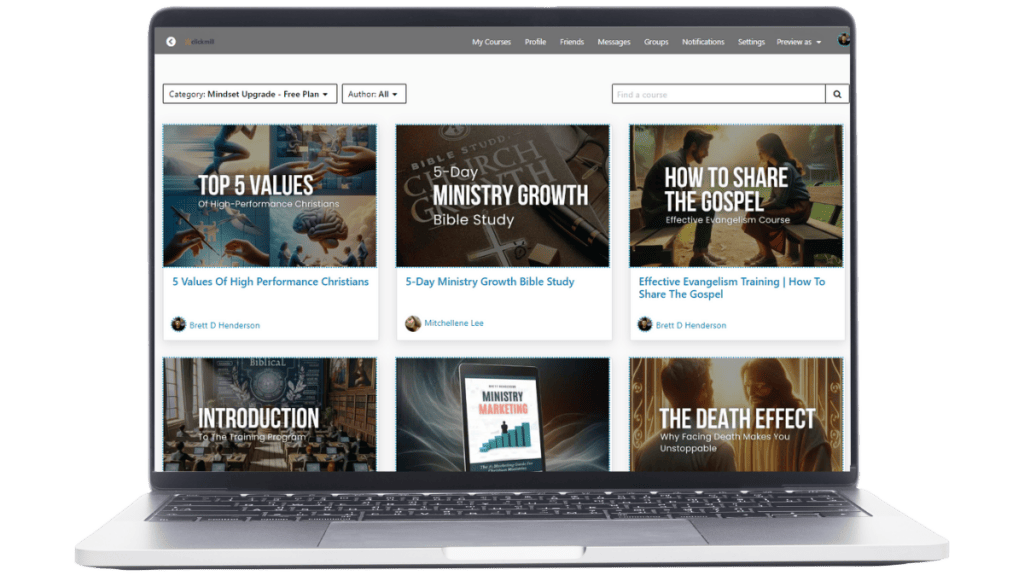In today’s digital era, churches stand at a crossroads. Church Social Media Marketing offers a path to extend their reach and deepen connections.
But how can platforms like Facebook, Instagram, and Twitter be harnessed to foster a thriving church community?
The Apostle Paul wrote in Romans 10:14 ,
“How can they believe in the one of whom they have not heard? And how can they hear without someone preaching to them?”
In this spirit, the digital realm becomes our modern pulpit, a place to share, connect, and grow.
This blog will explore practical strategies for churches to navigate the world of social media marketing.
Ready to amplify your church’s digital voice and community? Let’s dive in.
The Biblical Approach to Church Social Media Marketing

The Bible, while written centuries ago, offers timeless wisdom and principles that can guide modern practices, including Church Social Media Marketing.
By examining the teachings and methods of Jesus, churches can craft a more effective and meaningful social media strategy.
Knowing Your Flock: The Importance of Target Market
Just as Jesus was acutely aware of his audience, from fishermen to tax collectors, churches must understand their target market.
Recognizing their demographics, preferences, and pain points is essential. After all, wasn’t it Jesus who said,
“I know my sheep and my sheep know me” –John 10:14
For a pastor, this means diving deep into understanding the congregation and the larger community. What are their interests? Their challenges? Their aspirations?
By understanding these nuances, churches can tailor their social media content to resonate more deeply, just as Jesus tailored his parables to the listeners’ understanding.
get 4 FREE Online Church Growth courses + 2 Ebooks, & More!
Access 4 Courses, 2 eBooks, Live Group Chat, Live Online Classes & More! Get The Growth God Has For Your Ministry – Get Your Free Account Today!

Direct Engagement: Lessons from Jesus
Jesus didn’t just preach from the mountaintop; he walked among the people, engaging directly with them.
He listened to their stories, answered their questions, and offered guidance. This direct engagement built trust, fostered relationships, and created a community of believers.
In the realm of Church Social Media Marketing, this translates to active participation on social media platforms.
It’s not enough to simply post content; churches must also interact with their followers. Respond to comments, engage in discussions, share stories, and be present.
By doing so, churches can create a virtual community that feels connected, valued, and heard.
Furthermore, Jesus often met people where they were, both physically and emotionally.
Churches can take a cue from this by meeting their audience on their preferred social media platforms, understanding the nuances of each platform, and crafting content that fits the platform’s unique style and audience.
Addressing Genuine Needs: Beyond the Physical
Every community has its unique set of challenges, desires, and aspirations. For churches, understanding these nuances is paramount to creating a meaningful connection.
Jesus, in his teachings, often addressed the immediate, physical needs of the people, such as healing the sick or feeding the hungry.
But he didn’t stop there. He delved deeper, addressing the emotional, mental, and moral dilemmas faced by individuals.
In the context of Church Social Media Marketing, this means not only sharing content about upcoming events or services but also addressing the broader concerns of the community.
Are there concerns about family values in modern times? Questions about navigating moral dilemmas in today’s world? Or perhaps a need for guidance on personal growth and development?
By addressing these genuine needs through content, churches can position themselves as a beacon of guidance and support.
Moreover, by sharing testimonials, stories of transformation, and real-life experiences of congregation members, churches can showcase the tangible impact of their community.
Such content not only resonates deeply but also builds trust and credibility.
The Sacred Call to Action
Every message, parable, or teaching of Jesus had a purpose. He didn’t just provide wisdom and leave it at that.
He often ended with a call to action – a step that the listener should take, be it a change in behavior, a commitment to a cause, or a directive to spread the word.
Similarly, in the realm of Church Social Media Marketing, after delivering valuable content, there must be a clear and compelling call to action (CTA).
This CTA serves as a guidepost, directing the audience on what they should do next. It’s the bridge between passive consumption of content and active engagement with the church’s mission.
For instance, after sharing a heartfelt testimonial video, the CTA could be an invitation to join a group session or a workshop. A post discussing family values might end with a prompt to sign up for a family counseling session or a family retreat weekend.
An inspirational quote or scripture could be followed by an invitation to attend the next service or join a Bible study group.
But it’s essential that these CTAs are not just generic. They should be specific, actionable, and resonate with the content shared.
For example, instead of a vague “Join us this Sunday,” a more engaging CTA could be “Experience the warmth of our community this Sunday at 10 AM. We have a special session on ‘Finding Peace in Chaotic Times’. Don’t miss it!”
Furthermore, it’s crucial to make the process of following through on the CTA as seamless as possible. If you’re asking them to sign up for something, provide a direct link.
If you’re inviting them to an event, offer a map, timings, and other relevant details.
In essence, the sacred call to action is not just about increasing numbers or engagement metrics.
It’s about guiding the audience towards a deeper connection with the church and its mission. It’s about fostering commitment, participation, and a sense of belonging.
get 4 FREE Online Church Growth courses + 2 Ebooks, & More!
Access 4 Courses, 2 eBooks, Live Group Chat, Live Online Classes & More! Get The Growth God Has For Your Ministry – Get Your Free Account Today!

The Ultimate Goal of Church Social Media Marketing
In the vast digital landscape, where attention spans are fleeting and distractions are many, churches face the challenge of not just capturing attention, but also retaining and deepening engagement.
Social media is a starting point, a doorway if you will, but the journey extends much beyond.
Moving Beyond Social Media: The Real Objective
While platforms like Facebook, Instagram, and Twitter offer a vast audience, they are, at the end of the day, just platforms. The real essence of the church – its teachings, its community, and its mission – exists beyond these digital walls.
Thus, while social media is a potent tool for outreach, the ultimate goal of Church Social Media Marketing is to transition individuals from these platforms onto the church’s own websites.
Imagine social media as the shores of the Sea of Galilee, where Jesus first called his disciples.
The initial call was there, but the journey, the teachings, and the deeper engagements happened as they traveled together. Similarly, churches should view social media as a place to make that initial call, to pique interest, and then guide individuals to deeper waters – be it through church services, community events, workshops, or personal interactions.
Crafting Engaging Content to Drive Traffic
Content acts as the beacon, the guiding light that attracts and then directs. But in a world inundated with content, how do churches ensure theirs stands out?
The key lies in resonance. By crafting content that speaks directly to the needs, aspirations, and challenges of their audience, churches can create a magnetic pull.
For instance, a video discussing modern-day challenges in parenting from a biblical perspective can attract parents in the congregation.
An article or a webinar on finding balance and purpose in today’s fast-paced world can resonate with many feeling overwhelmed.
And once this content captures attention, it should seamlessly guide the audience to the church’s platforms – be it a website, a sign-up form for an event, or a portal for online services.
Building a Community, Not Just Followers
In the digital age, numbers can be deceptive. Having thousands of followers might look impressive, but if these followers are passive, the impact is minimal.
Churches should aim not just for followers but for a community. A community that interacts, that shares, that discusses, and that actively participates in the church’s mission.
This involves regular engagement, two-way communication, and providing avenues for followers to participate actively.
It could be through online Bible study groups, virtual prayer meets, or discussion forums on the church’s website. The idea is to make every follower feel valued, heard, and an integral part of the church’s journey.
The real impact happens when the digital engagement translates into real-world interactions, deepening faith, fostering community, and furthering the church’s mission.
If you’re finding this content valuable, you won’t want to miss our detailed guide on ’10 UNKNOWN CHURCH SOCIAL MEDIA STRATEGIES].’
get 4 FREE Online Church Growth courses + 2 Ebooks, & More!
Access 4 Courses, 2 eBooks, Live Group Chat, Live Online Classes & More! Get The Growth God Has For Your Ministry – Get Your Free Account Today!

Practical Steps for Effective Church Social Media Marketing

Embarking on the journey of Church Social Media Marketing requires a strategic approach, ensuring that every post, every interaction, and every piece of content aligns with the church’s mission and reaches the right audience.
Identifying the Right Platforms
Different social media platforms cater to different demographics and serve different purposes.
It’s crucial for churches to identify which platforms are most effective for reaching their target audience.
- Facebook: With its vast user base, Facebook is a great platform for reaching a wide audience. However, the key is to go beyond your own church’s Facebook page. Search for groups that resonate with your target audience and engage with them genuinely. Instead of spamming these groups with promotional content, participate in discussions, offer valuable insights, and build relationships. When you do share content from your own platform, ensure it’s relatable and introduces your platform in a way that adds value to the audience.
- YouTube: Youtube for Churches is an excellent platform for sharing video content, from sermons and testimonies to music and event highlights. To ensure your content reaches the right audience, focus on keyword targeting. Use relevant keywords in your video titles, descriptions, and tags. This helps your content show up in search results and recommendations, reaching individuals interested in church-related content.
Leveraging SEO
Search Engine Optimization (SEO) is not just for websites; it’s also crucial for social media content.
Understanding how to use keywords and SEO techniques ensures that your content is discoverable and reaches the right people.
- Keyword Research: Identify keywords that your target audience is likely to use when searching for content related to your church or faith. Tools like Google Keyword Planner can help you find relevant keywords.
- Optimize Your Content: Once you have your keywords, incorporate them naturally into your social media posts, video titles, descriptions, and tags. However, avoid keyword stuffing. The content should still be engaging and provide value to the audience.
- Track and Analyze: Use analytics tools to track the performance of your content. See which posts are getting the most engagement and which keywords are driving traffic to your content. Use this data to refine your strategy and improve future posts.
By identifying the right platforms and leveraging SEO, churches can ensure that their social media marketing efforts are effective, reaching the right audience, and contributing to the growth and engagement of their community.
Interested in taking your church’s online presence to the next level? Dive deeper into the world of Church SEO with our comprehensive guide, available here: Best Church SEO Practices.
get 4 FREE Online Church Growth courses + 2 Ebooks, & More!
Access 4 Courses, 2 eBooks, Live Group Chat, Live Online Classes & More! Get The Growth God Has For Your Ministry – Get Your Free Account Today!

Overcoming Challenges in Church Social Media Marketing
Navigating the world of social media marketing for churches comes with its unique set of challenges.
From budget constraints to engaging a diverse congregation, churches must find innovative solutions to make the most of their online presence.
Budget Constraints and Solutions
Every church, big or small, often grapples with budget constraints. When it comes to social media marketing, the good news is that there are several cost-effective strategies that can deliver impactful results:
Leverage Organic Reach: Before diving into paid promotions, focus on building organic reach. Engage with your audience, encourage sharing, and create content that resonates. The more engagement your posts get, the more they’ll be seen.
Utilize Free Tools: There are numerous free tools available for content creation, scheduling, and analytics. Tools like Canva can help create visually appealing graphics, while platforms like Hootsuite or Buffer allow for scheduling posts in advance.
Collaborate with Influencers: Engage with local influencers or community leaders who align with your church’s values. They can help amplify your message without the hefty price tag of traditional advertising.
Host Virtual Events: Instead of spending on physical events, consider hosting webinars, live Q&A sessions, or virtual prayer meets. These can be done at a fraction of the cost and have the potential to reach a global audience.
Encourage User-Generated Content: Encourage your congregation to share their stories, testimonials, and experiences. Not only is this free, but it also adds authenticity to your content.
Engaging the Youth and Keeping the Congregation Connected
The youth are not just the future of the church; they are its present. Engaging them is crucial for the vitality and longevity of the congregation. Here are some strategies:
Stay Updated with Trends: The digital landscape is ever-evolving. Stay updated with the latest trends, platforms, and content preferences of the younger generation.
Interactive Content: The youth prefer interactive content. Consider hosting polls, quizzes, challenges, or Q&A sessions that cater to their interests.
Collaborate with Youth Leaders: Empower the youth leaders in your church to take charge of certain social media initiatives. They can provide insights into what resonates with their peers.
Create Youth-Centric Platforms: Consider having separate social media accounts or groups specifically for the youth. This can be a space for them to connect, share, and grow together.
Bridge the Gap: Use social media to bridge the gap between different age groups in your congregation. Share stories of intergenerational interactions, collaborations, and learnings.
Church Social Media Marketing is more than just a digital strategy; it’s a ministry.
It’s about reaching out, connecting, and building a community in the digital age. With the right approach, churches can harness the power of social media to grow, engage, and inspire.
It’s about meeting people where they are and guiding them towards a deeper connection with the church and its mission.
In this journey, challenges are but stepping stones, leading the way to a more connected and vibrant church community.
get 4 FREE Online Church Growth courses + 2 Ebooks, & More!
Access 4 Courses, 2 eBooks, Live Group Chat, Live Online Classes & More! Get The Growth God Has For Your Ministry – Get Your Free Account Today!

Church Social Media Marketing FAQs
Why is social media important for churches?
Social media offers churches a platform to reach a wider audience, engage with their community, and share their message.
How often should a church post on social media?
It varies, but consistency is key. Whether it’s daily, weekly, or bi-weekly, it’s essential to maintain a regular posting schedule.
What type of content should churches share?
Messages that resonate with the church’s mission, event announcements, community stories, and more.
How can churches transition followers from social media to their own platforms?
Through engaging content, clear calls to action, and offering value that can only be found on their own platforms.
What are the benefits of Church Social Media Marketing?
Increased outreach, community engagement, growth in church membership, and a stronger online presence.
How has Church Social Media Marketing influenced your congregation’s engagement? Let us know in the comments!


Responses